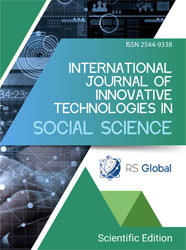BURNOUT AS AN “OCCUPATIONAL PHENOMENON” AMONG HEALTHCARE WORKERS AND COPING STRATEGIES – A REVIEW OF LITERATURE
Abstract
Introduction: Burnout is a syndrome that has become a major problem in modern, hectic lives. It is scientifically proven that the medics report higher level of burnout than any other working field. It has been recognized as a exhaustion, depersonalization and decreased satisfaction and efficiency at work. It leads to severe states like depression, anxiety and permanent weariness. It can cause drastic deterioration in the health care system and have negative consequences for the patients. Therefore, we undertook this study to investigate the scale of the problem.
Materials and Methods: A detailed review of literature was conducted to investigate the problem of burnout and to focus on possible coping strategies using PubMed, Google Scholar and MEDLINE databases.
Keywords: burn-out, medical burn-out, occupational stress, coping strategies, physicians, medical students, mindfulness, exhaustion, occupational burn-out
Results: Data shows that 50% of physicians are affected by burnout syndrome. Documented symptoms are both mental and physical, most common are depression, anxiety and lack of work satisfaction. The scale of the suffering healthcare workers reached its peak during COVID-19 pandemic. Women declared higher levels of burn-out, comparing to male coworkers. The problem occurs at the early stages of medical career, as around 20% of medical students declared adequate symptoms.
Conclusions: Burn-out phenomenon must be taken under further research, as it becomes worldwide health issue among healthcare workers. It is essential to spread awareness, encourage medics to seek for professional help and collect a significant amount of data to prepare a concrete strategies and treatments programs.
References
Freudenberger, H. J. (1974). Staff burn‐out. Journal of Social Issues, 30(1), 159–165. https://doi.org/10.1111/j.1540-4560.1974.tb00706.x
Khammissa, R. A. G., Nemutandani, S., Feller, G., Lemmer, J., & Feller, L. (2022). Burnout phenomenon: Neurophysiological factors, clinical features, and aspects of management. Journal of International Medical Research, 50(9), 03000605221106428. https://doi.org/10.1177/03000605221106428
Fares, J., Al Tabosh, H., Saadeddin, Z., El Mouhayyar, C., & Aridi, H. (2016). Stress, burnout and coping strategies in preclinical medical students. North American Journal of Medical Sciences, 8(2), 75. https://doi.org/10.4103/1947-2714.177299
Cohen, C., Pignata, S., Bezak, E., Tie, M., & Childs, J. (2023). Workplace interventions to improve well-being and reduce burnout for nurses, physicians and allied healthcare professionals: A systematic review. BMJ Open, 13(6), e071203. https://doi.org/10.1136/bmjopen-2022-071203
Tement, S., Ketiš, Z. K., Miroševič, Š., & Selič-Zupančič, P. (2021). The impact of psychological interventions with elements of mindfulness (PIM) on empathy, well-being, and reduction of burnout in physicians: A systematic review. International Journal of Environmental Research and Public Health, 18(21), 11181. https://doi.org/10.3390/ijerph182111181
Franklin, P., & Gkiouleka, A. (2021). A scoping review of psychosocial risks to health workers during the COVID-19 pandemic. International Journal of Environmental Research and Public Health, 18(5), 2453. https://doi.org/10.3390/ijerph18052453
Araç, S., & Dönmezdil, S. (2020). Investigation of mental health among hospital workers in the COVID-19 pandemic: A cross-sectional study. São Paulo Medical Journal, 138(5), 433–440. https://doi.org/10.1590/1516-3180.2020.0272.r3.21072020
Luceño-Moreno, L., Talavera-Velasco, B., García-Albuerne, Y., & Martín-García, J. (2020). Symptoms of posttraumatic stress, anxiety, depression, levels of resilience and burnout in Spanish health personnel during the COVID-19 pandemic. International Journal of Environmental Research and Public Health, 17(15), 5514. https://doi.org/10.3390/ijerph17155514
Wurm, W., et al. (2016). Depression-burnout overlap in physicians. PLOS ONE, 11(3), e0149913. https://doi.org/10.1371/journal.pone.0149913
Cohen, S., Janicki-Deverts, D., & Miller, G. E. (2007). Psychological stress and disease. JAMA, 298(14), 1685. https://doi.org/10.1001/jama.298.14.1685
Nater, U. M., Fischer, S., & Ehlert, U. (2011). Stress as a pathophysiological factor in functional somatic syndromes. Current Psychiatry Reviews, 7(2), 152–169. https://doi.org/10.2174/157340011796391184
Koutsimani, P., Montgomery, A., & Georganta, K. (2019). The relationship between burnout, depression, and anxiety: A systematic review and meta-analysis. Frontiers in Psychology, 10, 284. https://doi.org/10.3389/fpsyg.2019.00284
Hammarström, P., Rosendahl, S., Gruber, M., & Nordin, S. (2023). Somatic symptoms in burnout in a general adult population. Journal of Psychosomatic Research, 168, 111217. https://doi.org/10.1016/j.jpsychores.2023.111217
Riello, M., Purgato, M., Bove, C., MacTaggart, D., & Rusconi, E. (2020). Prevalence of post-traumatic symptomatology and anxiety among residential nursing and care home workers following the first COVID-19 outbreak in Northern Italy. Royal Society Open Science, 7(9), 200880. https://doi.org/10.1098/rsos.200880
Yin, Q., et al. (2020). Posttraumatic stress symptoms of health care workers during the coronavirus disease 2019. Clinical Psychology & Psychotherapy, 27(3), 384–395. https://doi.org/10.1002/cpp.2477
Hong, S., et al. (2021). Immediate psychological impact on nurses working at 42 government-designated hospitals during COVID-19 outbreak in China: A cross-sectional study. Nursing Outlook, 69(1), 6–12. https://doi.org/10.1016/j.outlook.2020.07.007
Witt, K., et al. (2019). Effectiveness of universal programmes for the prevention of suicidal ideation, behaviour and mental ill health in medical students: A systematic review and meta-analysis. Evidence-Based Mental Health, 22(2), 84–90. https://doi.org/10.1136/ebmental-2019-300082
Matheson, K. M., Barrett, T., Landine, J., McLuckie, A., Soh, N. L.-W., & Walter, G. (2016). Experiences of psychological distress and sources of stress and support during medical training: A survey of medical students. Academic Psychiatry, 40(1), 63–68. https://doi.org/10.1007/s40596-015-0395-9
Knipe, D., Maughan, C., Gilbert, J., Dymock, D., Moran, P., & Gunnell, D. (2018). Mental health in medical, dentistry and veterinary students: Cross-sectional online survey. BJPsych Open, 4(6), 441–446. https://doi.org/10.1192/bjo.2018.61
Busireddy, K. R., Miller, J. A., Ellison, K., Ren, V., Qayyum, R., & Panda, M. (2017). Efficacy of interventions to reduce resident physician burnout: A systematic review. Journal of Graduate Medical Education, 9(3), 294–301. https://doi.org/10.4300/JGME-D-16-00372.1
Tement, S., Ketiš, Z. K., Miroševič, Š., & Selič-Zupančič, P. (2021). The impact of psychological interventions with elements of mindfulness (PIM) on empathy, well-being, and reduction of burnout in physicians: A systematic review. International Journal of Environmental Research and Public Health, 18(21), 11181. https://doi.org/10.3390/ijerph182111181
Krasner, M. S. (2009). Association of an educational program in mindful communication with burnout, empathy, and attitudes among primary care physicians. JAMA, 302(12), 1284. https://doi.org/10.1001/jama.2009.1384
Koh, M. Y. H., et al. (2015). Burnout, psychological morbidity and use of coping mechanisms among palliative care practitioners: A multi-centre cross-sectional study. Palliative Medicine, 29(7), 633–642. https://doi.org/10.1177/0269216315575850
Maresca, G., Corallo, F., Catanese, G., Formica, C., & Lo Buono, V. (2022). Coping strategies of healthcare professionals with burnout syndrome: A systematic review. Medicina, 58(2), 327. https://doi.org/10.3390/medicina58020327
Zakaria, N., Zakaria, N. H., Bin Abdul Rassip, M. N. A., & Lee, K. Y. (2022). Burnout and coping strategies among nurses in Malaysia: A national-level cross-sectional study. BMJ Open, 12(10), e064687. https://doi.org/10.1136/bmjopen-2022-064687
Goldberg, R., et al. (1996). Burnout and its correlates in emergency physicians: Four years’ experience with a wellness booth. Academic Emergency Medicine, 3(12), 1156–1164. https://doi.org/10.1111/j.1553-2712.1996.tb03379.x
Naczenski, L. M., De Vries, J. D., Van Hooff, M. L. M., & Kompier, M. A. J. (2017). Systematic review of the association between physical activity and burnout. Journal of Occupational Health, 59(6), 477–494. https://doi.org/10.1539/joh.17-0050-RA
Parkerson, G. R., Broadhead, W. E., & Tse, C. K. (1990). The health status and life satisfaction of first-year medical students. Academic Medicine, 65(9), 586–588. https://doi.org/10.1097/00001888-199009000-00009
World Health Organization. (2019, May 28). Burn-out an "occupational phenomenon": International classification of diseases. World Health Organization. https://www.who.int/news/item/28-05-2019-burn-out-an-occupational-phenomenon-international-classification-of-diseases
Views:
18
Downloads:
11
Copyright (c) 2025 Hanna Paszkiewicz, Oliwia Gugała, Kamil Nowak, Alicja Stryczek-Schlusche, Patryk Kowalczyk, Bartłomiej Trzciński, Igor Winogrodzki, Aleksandra Magdalena Furczyńska, Filip Bracichowicz, Aleksandra Gęsińska

This work is licensed under a Creative Commons Attribution 4.0 International License.
All articles are published in open-access and licensed under a Creative Commons Attribution 4.0 International License (CC BY 4.0). Hence, authors retain copyright to the content of the articles.
CC BY 4.0 License allows content to be copied, adapted, displayed, distributed, re-published or otherwise re-used for any purpose including for adaptation and commercial use provided the content is attributed.















